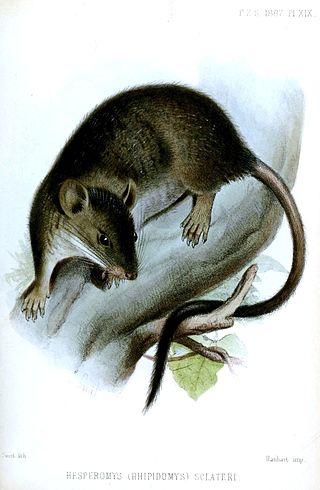
The Muroidea are a large superfamily of rodents, including mice, rats, voles, hamsters, lemmings, gerbils, and many other relatives. Although the Muroidea originated in Eurasia, they occupy a vast variety of habitats on every continent except Antarctica. Some authorities have placed all members of this group into a single family, Muridae, due to difficulties in determining how the subfamilies are related to one another. Many of the families within the Muroidea superfamily have more variations between the families than between the different clades. A possible explanation for the variations in rodents is because of the location of these rodents; these changes could have been due to radiation or the overall environment they migrated to or originated in. The following taxonomy is based on recent well-supported molecular phylogenies.

Dendromurinae is a subfamily of rodents in the family Nesomyidae and superfamily Muroidea. The dendromurines are currently restricted to Africa, as is the case for all extant members of the family Nesomyidae. The authorship of the subfamily has been attributed to both Alston, 1876, and (incorrectly) to G. M. Allen, 1939.

The subfamily Tylomyinae consists of several species of New World rats and mice including the vesper and climbing rats. They are not as well known as their relatives in the subfamilies Sigmodontinae and Neotominae. Many authorities place all three of these subfamilies in a single subfamily, Sigmodontinae.

Oligoryzomys nigripes, also known as the black-footed colilargo or the black-footed pygmy rice rat, is a rodent in the genus Oligoryzomys of family Cricetidae. Oligoryzomys nigripes is a species that has been further divided into different sister taxa throughout history. It is found in different countries in South America. It is a large species with long ears, dark yellow to dark brown upperparts, sharply delimited from the whitish underparts, and often a pink girdle on the chest. This species of rat spends much of its life among the trees. The karyotype is 2n = 62, FNa = 78–82.

Rhipidomys is a genus of rodents in the family Cricetidae, The following 25 species of climbing mouse species are currently recognised:

The Mindoro climbing rat or Mindoro rat is a species of rodent in the family Muridae. It is found only in the Philippines, and is known only from Ilong Peak in the Halcon Mountains. It is the only species in the genus Anonymomys. Its natural habitat is subtropical or tropical dry forest. It is threatened by habitat loss.

Holochilus chacarius, also known as the Chacoan marsh rat or Chaco marsh rat, is a semiaquatic species of rodent in the family Cricetidae. It is found in Argentina and Paraguay within the Gran Chaco.

The big-eared climbing rat is a species of rodent in the family Cricetidae. It is found in Central America from Mexico to Costa Rica.

The Himalayan field rat, sometimes known as the white-footed Indo-Chinese rat, is a species of rodent in the family Muridae. It has a wide range, being found in India, Bangladesh, Nepal, Bhutan, China, Myanmar, Laos, Thailand, and Vietnam, with introduced populations in Indonesia (widely), Palau, and the Philippines. A common species, the International Union for Conservation of Nature has assessed its conservation status as being of "least concern".
The Chiapan climbing rat is a species of rodent in the family Cricetidae. It is found only in Mexico. The species is known from only one location in Tuxtla Gutiérrez, Chiapas. The habitat in the region is being converted to agricultural and urban use, which is likely causing critical declines in numbers of T. bullaris.
The fulvous-bellied climbing rat is a species of rodent in the family Cricetidae. It is found only in Panama.
The Mira climbing rat is a species of rodent in the family Cricetidae. It is found in Colombia and Ecuador.
Peters's climbing rat is a species of rodent in the family Cricetidae.

The Panamanian climbing rat is a species of rodent in the family Cricetidae. It is endemic to Panama.
The Tumbala climbing rat is a species of rodent in the family Cricetidae. It is found in Mexico, where it is known only from one locality in Tumbalá, Chiapas. The species is threatened by deforestation.
Watson's climbing rat is a species of rodent in the family Cricetidae. It is found in Costa Rica and Panama.

Tylomyini is a tribe of New World rats and mice in the subfamily Tylomyinae. The rats share the characteristics of all being climbing rats.










